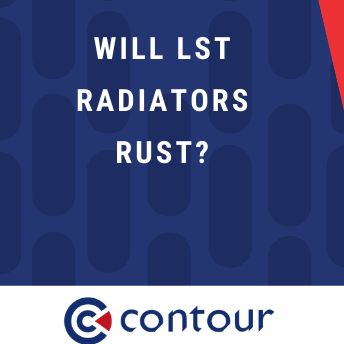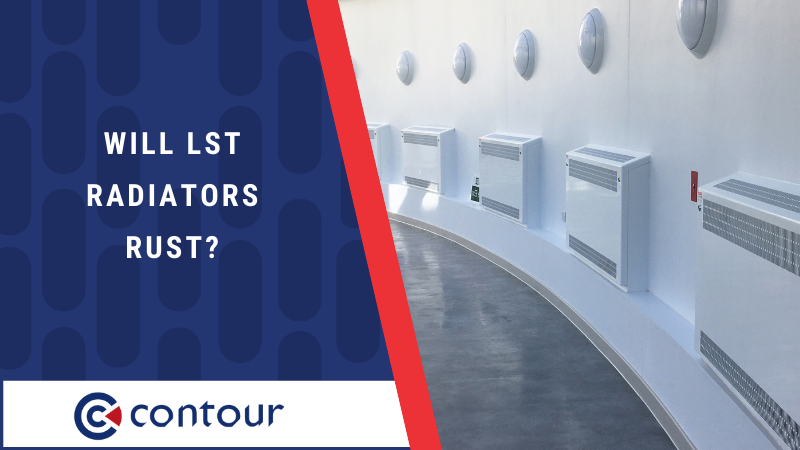
Contour: What are the chances of my LST Radiator rusting?
Most modern radiators are designed to withstand a certain degree of rust and corrosion. But, in moisture-rich environments like bathrooms and wet rooms, you should ensure are coated with magnelis steel. Contour explains more…

Rust. We all hate it. The earth-coloured tone that our metal products gradually develop when exposed to moisture for long periods of time.
From the chassis of an historic car or an old trolley hauled out of a canal, it’s apparent in all walks of life, causing long lasting damage to the structure and integrity of the original product.
Of course, LST (low surface temperature) radiators are metallic items, and therefore open themselves up to the possibility of rusting.
However, down to state-of-the-art features LST radiators have, they aren’t going to succumb to the pitfalls of rusting and corrosion.
Here, Contour discusses what causes the rusting process and how its range of LST radiators prevents this happening.
LST Radiators & Rusting
We all know what causes rusting.
While at first glance it appears as a form of robotic gangrene eating away at metallic flesh, the more scientific causation is less exciting. Simply put, rusting is a chemical reaction that occurs when iron or iron-based alloys become exposed to moisture and oxygen for extended periods of time.
This causes something of a catch-22. LST radiators are essential for environments such as mental health wet rooms or care home toilets. However, these are the environments that can cause the most severe rusting to metal appliances.
Think about it. If water is 50% of the rusting equation, an environment such as a bathroom where water is omnipresent, the risk of rusting significantly increases.
And a rusty radiator is a dangerous one. As surfaces become more corroded, they lose their strength. Not only does this affect the potential efficiency of the radiator, but it could also be a matter of time before it the damage causes the radiator to fall from its position.
This is why Contour’s range of LST radiators for wet rooms and other similar environments are designed differently…
What Materials Are LST Radiators Made From?
Traditionally speaking, LST radiators for the likes of schools, nurseries and communal mental health, care home and hospital environments are made from zintec steel manufactured at just 1.5mm thickness.
This is steel that has a thin layer of zinc applied. This means it combats against the threat of rusting, making it the ideal solution.
However, as we’ve touched on, some environments such as wet rooms and toilets are more exposed to moisture then others. While Zintec LST radiators would get the job done in the short term, over extended periods of time, our friend rust would soon appear.
Because of this, some of Contour’s LST radiators – especially those used in more moisture rich environments – are made from zintec but from magnelis.
Like zintec, magnelis fights against the risk of rust and corrosion but is an even stronger solution. The process is similar to galvanising, where material is dipped into a solution of zinc alloy to help protect against rust.
And when you think about it, when was the last time you saw a rusting outdoor steel gatepost? You didn’t because it was galvanised, and magnelis provides similar protection for domestic appliances like LST radiators.
Conclusion
And there you have it. So, in terms of will your LST radiator rust, he easy answer is ‘it depends’ – but that means very little.
It all comes down to two factors. The first is where your LST radiator is going to be used, is the environment going to high in moisture for example. The second is what you LST radiator is going to be made from.
While LST radiators in communal areas such as bedrooms and living quarters are zinc coated, over time, general wear and tear can lead to rust and corrosion. This is why magnelis is used when manufacturing Contour’s LST radiators.
This material helps take rust and corrosion protection to the next level making them safe to use in all environments.
Interested in finding out more? Get in touch with our expert team today.
Contour can be contacted at;
The Mansions
43 Broadway
Shifnal
TF11 8BB
Tel: 01952 290 498
Email: sales@contourheating.co.uk
Visit Supplier's page
Latest news

28th March 2025
Ideal Heating Commercial announces 10-year warranty on Evomax 2 boiler
Evomax 2, the UK’s number one selling commercial wall-mounted boiler from Ideal Heating Commercial, is now available with a 10-year warranty.
Posted in Articles, Building Industry News, Building Products & Structures, Building Regulations & Accreditations, Building Services, Facility Management & Building Services, Heating Systems, Controls and Management, Heating, Ventilation and Air Conditioning - HVAC, Innovations & New Products, Pipes, Pipes & Fittings, Plumbing, Retrofit & Renovation, Sustainability & Energy Efficiency, Videos
28th March 2025
FLIR Si1-LD Acoustic Imaging Camera for Compressed Air Leak Detection
FLIR, a Teledyne Technologies company, introduces the Si1-LD, an industrial acoustic imaging camera that brings faster and more accurate compressed air leak detection to those operating on a modest condition monitoring budget.
Posted in Acoustics, Noise & Vibration Control, Articles, Building Industry News, Building Products & Structures, Building Services, Facility Management & Building Services, Information Technology, Innovations & New Products, Retrofit & Renovation, Sustainability & Energy Efficiency, Thermal Imaging and Monitors
28th March 2025
LIFTEX 2025 Seminar programme announced
Registration has opened for LIFTEX 2025. Now in its 37th year, LIFTEX 2025 is the UK’s only dedicated exhibition for the lift, escalator and access industry and takes place only once every three years.
Posted in Access Control & Door Entry Systems, Accessibility, Articles, Building Industry Events, Building Industry News, Building Products & Structures, Building Regulations & Accreditations, Building Services, Exhibitions and Conferences, Facility Management & Building Services, Health & Safety, Retrofit & Renovation, Security and Fire Protection, Seminars
28th March 2025
MCRMA welcomes ArcelorMittal UK to membership
A UK division of the global steelmaking business ArcelorMittal has become the latest new member of the MCRMA, the industry association representing the metal building envelope sector.
Posted in Articles, Building Associations & Institutes, Building Industry News, Building Products & Structures, Building Systems, Cladding, Facades, Posts, Restoration & Refurbishment, Retrofit & Renovation, Roofs, Steel and Structural Frames, Walls
 Sign up:
Sign up: